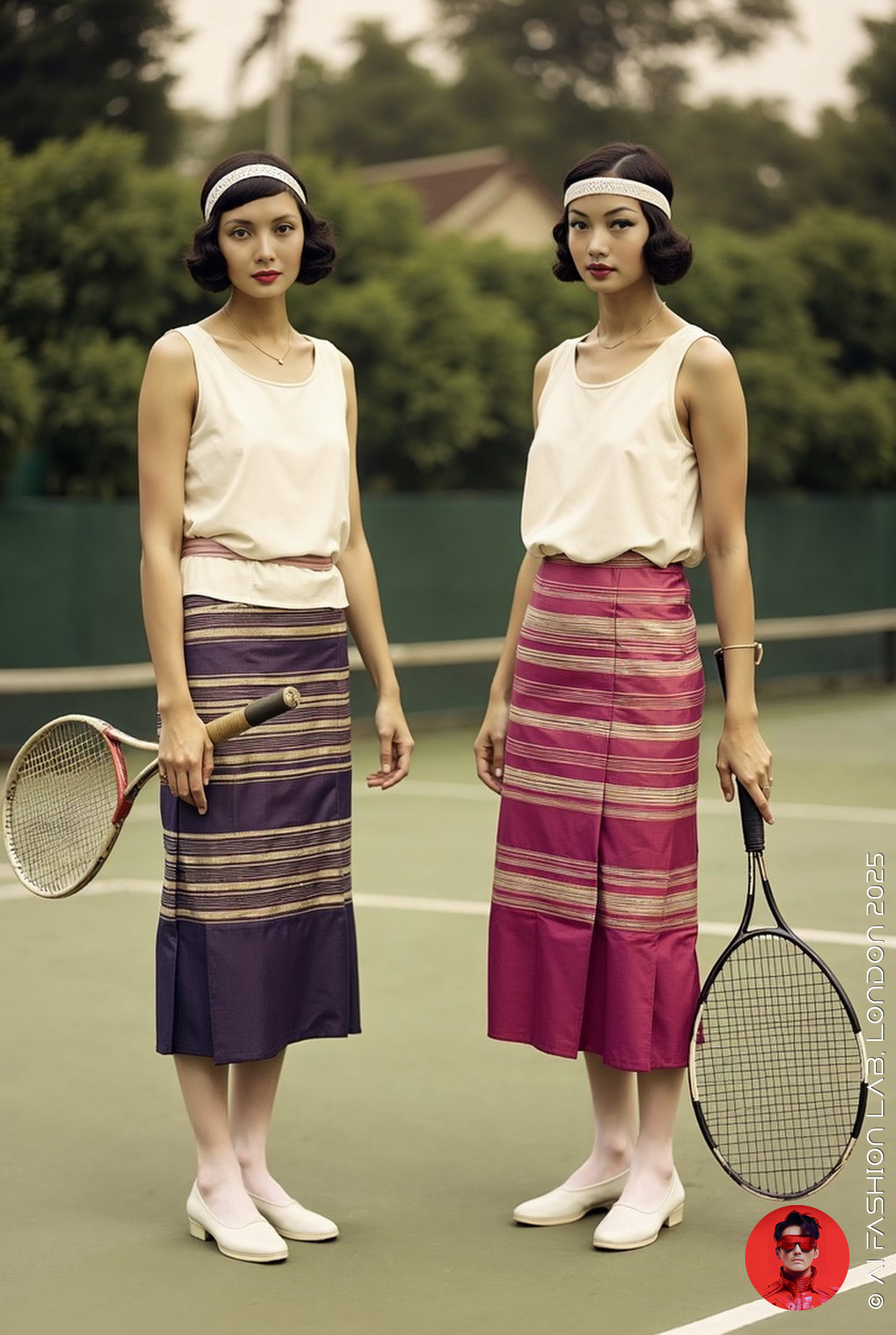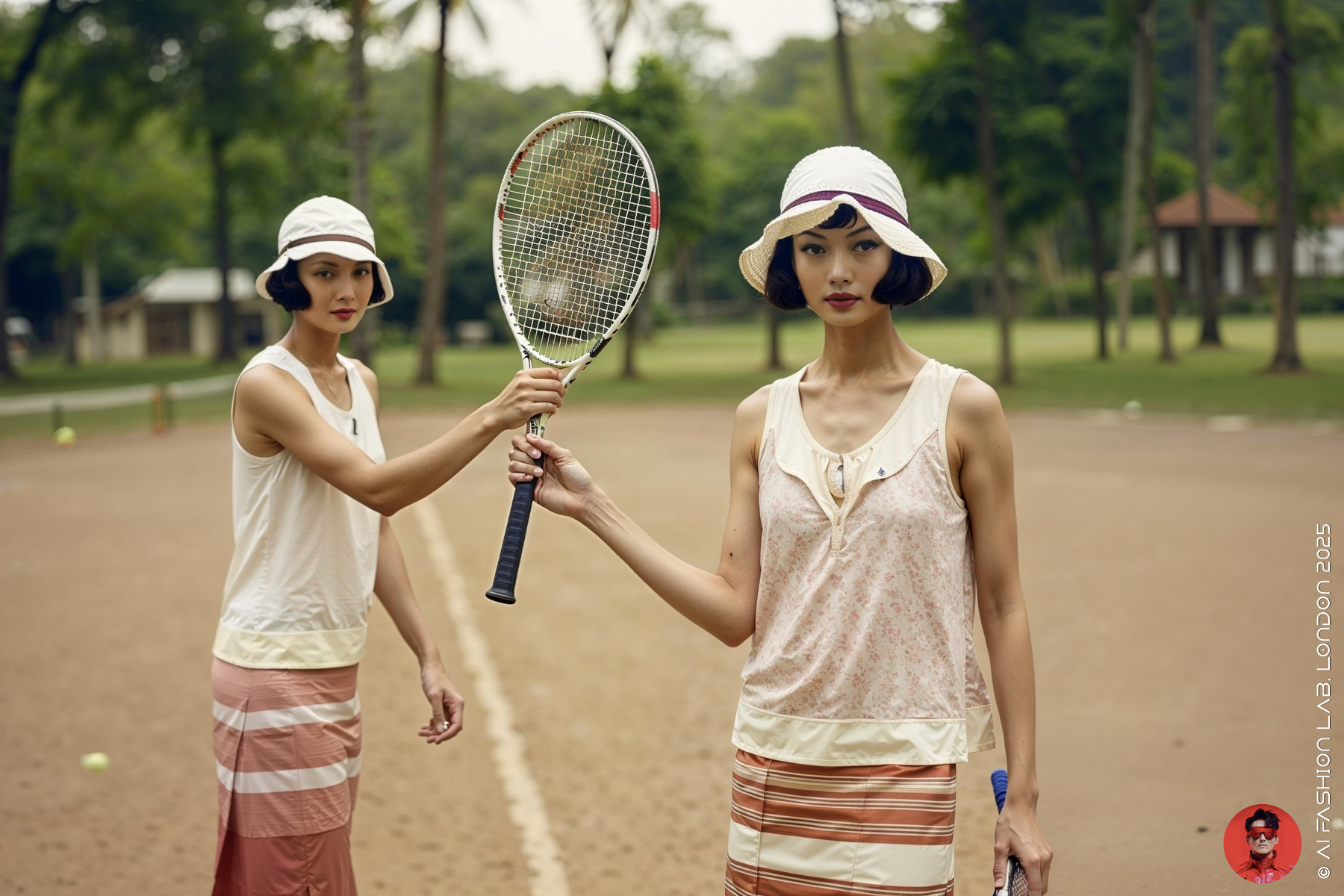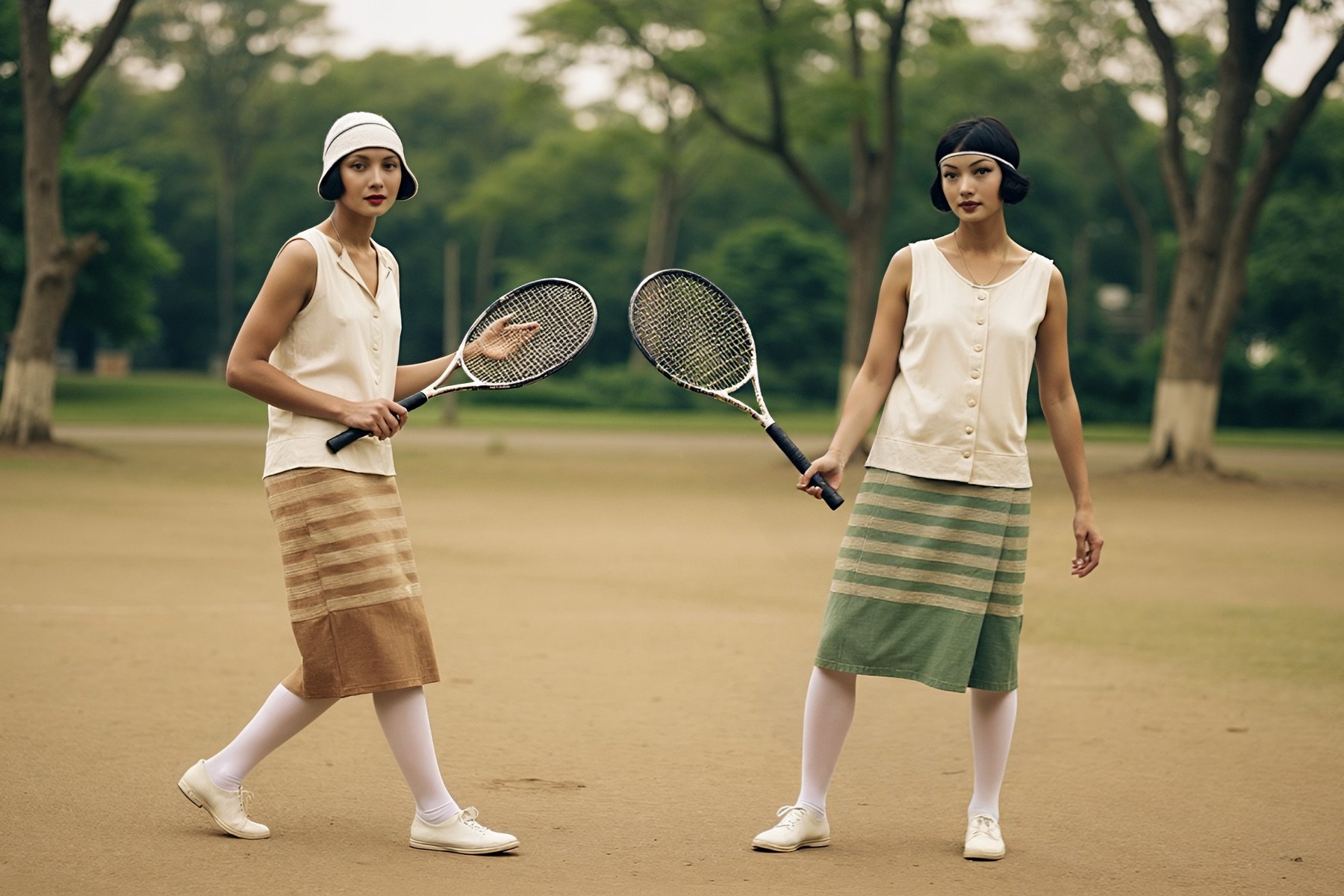จินตนาการแฟชั่นกีฬาเทนนิสในประเทศไทย สมัยรัชกาลที่ ๗
จินตนาการแฟชั่นกีฬาเทนนิสในประเทศไทย สมัยรัชกาลที่ ๗
ในยุคที่ประเพณีและนวัตกรรมมาบรรจบกัน คอลเลกชันภาพจากการเทรน AI ด้วย Flux LoRA นี้ ได้จินตนาการถึงแฟชั่นของหญิงไทยที่เล่นกีฬาเทนนิสในรัชสมัย พระบาทสมเด็จพระปกเกล้าเจ้าอยู่หัว (รัชกาลที่ 7) ระหว่าง พ.ศ. 2468–2475 โดยสะท้อนสไตล์การแต่งกายที่ผสมผสานระหว่าง แฟชั่นยุคแฟลปเปอร์ของตะวันตก กับ แฟชั่นไทยแบบผสมผสาน ด้วยผ้าซิ่น คู่กับเสื้อแขนกุดที่เคลื่อนไหวได้คล่องตัว เหมาะกับการวิ่งตีลูกเทนนิสในสนามลอนเทนนิสที่มักเป็นพื้นดินในยุคนั้น
แรงบันดาลใจ
แรงบันดาลใจเกิดจากภาพถ่ายของสุภาพสตรีไทยที่เล่น แบดมินตัน โดยสวมผ้าซิ่นกับเสื้อแบบตะวันตก เป็นการแต่งกายที่ทั้งสวยงามและสามารถเคลื่อนไหวได้สะดวก ภาพถ่ายขาวดำดังกล่าวเป็นจุดตั้งต้นของคอลเลกชันนี้ ส่วนภาพสีทั้งหมด เป็นการสร้างสรรค์ขึ้นมาใหม่ด้วย AI เพื่อนำเสนอแนวคิดด้านแฟชั่นในรูปแบบภาพจำลอง ทางประวัติศาสตร์ด้วย AI ที่แสดงให้เห็นถึงจินตนาการของการเล่นเทนนิสในสมัยนั้น ก่อนที่การแต่งตัวด้วยชุดกีฬาสีขาวตามตะวันตกจะเป็นที่นิยม
อิทธิพลแฟลปเปอร์ ผสมกลิ่นอายสยาม
รูปลักษณ์ที่ปรากฏในคอลเลกชันนี้สะท้อนอิทธิพลของ แฟชั่นแฟลปเปอร์ยุค 1920s ไม่ว่าจะเป็นเสื้อทรงหลวม คอเสื้อเปิด หมวกคลอช (cloche hats) หรือแถบคาดผม ทว่าองค์ประกอบทั้งหมดกลับมีรากฐานอยู่ในอัตลักษณ์ไทยอย่างชัดเจน ผ่านการเลือกใช้ ผ้าซิ่นลายทาง และการแมตช์กับเครื่องประดับยุคเก่า เช่น ไม้แร็กเกต ลูกไม้ ถุงเท้า และรองเท้า ซึ่งล้วนสะท้อนถึงแฟชั่นนักกีฬาในยุคนั้น
ฉากหลัง: สนามเทนนิสยุคแรก
สนามในจินตนาการของคอลเลกชันนี้มิใช่สนามหญ้าหรือพื้นสังเคราะห์แบบปัจจุบัน แต่เป็น สนามดิน ตามรูปแบบสนามลอนเทนนิสในสยามช่วงต้นคริสต์ศตวรรษที่ 20 ซึ่งมักพบในบ้านของนักการทูตชาวต่างชาติ หรือสถานทูต หรือสมาคมกีฬา สะท้อนถึงช่วงเริ่มต้นของวัฒนธรรมกีฬาเทนนิสในหมู่ชนชั้นนำ
ประวัติกีฬาเทนนิสในประเทศไทย
ไม่มีหลักฐานแน่ชัดว่าใครเป็นผู้นำกีฬาเทนนิสเข้ามาสู่ประเทศไทยและในสมัยใด...
ถึงแม้จะไม่มีหลักฐานแน่ชัดว่าใครเป็นผู้นำเทนนิสเข้าสู่ประเทศไทย แต่สันนิษฐานกันว่ากีฬานี้เริ่มขึ้นในรัชสมัย พระบาทสมเด็จพระจุลจอมเกล้าเจ้าอยู่หัว (รัชกาลที่ 5) โดยชาวอังกฤษและอเมริกันที่เดินทางเข้ามาทำงานในไทย ในช่วงแรก เทนนิสเป็นที่นิยมในกลุ่มชาวต่างชาติเท่านั้น ต่อมาจึงเริ่มมีเจ้านายและข้าราชการไทยเล่นบ้าง
ในยุคแรกนั้น บางท่านยังคงสวม ผ้าม่วง และบางคนยัง อมหมาก ขณะเล่น ต่อมาได้มีการรับแบบแผนฝรั่ง โดยเปลี่ยนมาสวม กางเกงขายาวสีขาว ซึ่งถือว่าสุภาพกว่า
จุดเริ่มต้นของสโมสรเทนนิส
ราว ปี พ.ศ. 2460 ประชาชนเริ่มให้ความสนใจกีฬานี้มากขึ้น จึงมีการตั้ง สโมสรเทนนิสแห่งแรก ที่สวนสราญรมย์ โดยมีสมาชิกเพียง 10 คน ต่อมาย้ายไปที่พิพิธภัณฑ์สถานแห่งชาติ แต่ก็ยุบตัวไปในที่สุด ในช่วงเวลาใกล้เคียงกันก็มีสโมสรอื่นๆ เช่น บางกอกยูไนเต็ดคลับ และสนามเทนนิสส่วนตัวของชาวต่างชาติ เช่น ที่บ้าน มิสเตอร์ลอฟตัส (ใกล้โรงเรียนนายเรือ), บ้าน หมอแม็คฟาแลนด์ (โรงพยาบาลศิริราช), และ บ้านมิสเตอร์บัสโฟร์ หลังฐานทัพเรือ
การก่อตั้งลอนเทนนิสสมาคมแห่งประเทศไทย
ในปี พ.ศ. 2469 พระวรวงศ์เธอ กรมหมื่นพิทยาลงกรณ์ ได้ทรงจัดตั้ง ลอนเทนนิสสมาคมแห่งประเทศไทย โดยเชิญตัวแทนจาก 12 สโมสร อาทิ ราชกรีฑาสโมสร สโมสรสีลม สโมสรเชียงใหม่ยิมคานา และสโมสรสงขลา มาประชุมที่วังของพระองค์ และได้รับการแต่งตั้งเป็น นายกสมาคมคนแรก พร้อมออกกฎข้อบังคับซึ่งยังคงใช้มาจนถึงปัจจุบัน
วันที่ 15 เมษายน พ.ศ. 2470 จึงถือเป็น วันสถาปนาลอนเทนนิสสมาคมฯ อย่างเป็นทางการ และในปลายปีเดียวกัน สมาคมได้จัดการแข่งขันเทนนิสชิงแชมป์ประเทศไทยครั้งแรกที่ สโมสรสีลม พระบาทสมเด็จพระปกเกล้าเจ้าอยู่หัว ทรงรับสมาคมไว้ในพระบรมราชูปถัมภ์ และทรงโปรดกีฬาเทนนิสอย่างมาก โดยทรงตีเทนนิสเป็นประจำที่ วังสุโขทัย
พัฒนาการในยุคต่อมา
ปี พ.ศ. 2494 มีการออก ตราสัญลักษณ์ เป็นพระมหามงกุฎและเลข 7 เพื่อรำลึกถึงพระมหากรุณาธิคุณของ ร.7
ปี พ.ศ. 2495 มีการแปลกติกาลอนเทนนิสนานาชาติเป็นภาษาไทย
ปี พ.ศ. 2509 ไทยเป็นเจ้าภาพ กีฬาเอเชียนเกมส์ ครั้งที่ 5 โดยจัดแข่งเทนนิสที่สนามศุภชลาศัย
ปี พ.ศ. 2520 การกีฬาแห่งประเทศไทยสร้างสนามเทนนิส 6 คอร์ตที่หัวหมากและมอบให้ลอนเทนนิสสมาคมฯ ใช้เป็นสำนักงานใหญ่
ความสำเร็จระดับนานาชาติ
ปี พ.ศ. 2521 ที่ไทยเป็นเจ้าภาพ กีฬาเอเชียนเกมส์ ครั้งที่ 8 นักเทนนิสไทยประเภทคู่ผสมคือ จารึก เฮงรัศมี และ สุทธาสินี ศิริกายะ คว้าเหรียญทอง ปัจจุบันไทยมีนักเทนนิสระดับโลกหลายคน และมีแผนพัฒนาระยะยาวเพื่อยกระดับมาตรฐานให้ทัดเทียมกับชาติในยุโรปและอเมริกา
Court & Culture: Reimagining 1920s Thai Women’s Tennis Fashion with AI
In an era where tradition meets innovation, this AI-enhanced collection reimagines what Thai women might have worn while playing tennis during the reign of King Rama VII (1925–1935). This series pays homage to the graceful blend of Western flapper fashion and traditional Thai textiles, envisioning stylish female players wearing shortened pha-sin (ผ้าซิ่น) with sleeveless or soft-collared blouses—ideal for movement on earthy, lawn tennis courts of the early 20th century.
The Inspiration
The concept was sparked by a rare archival photograph of three Thai women playing badminton, dressed in pha-sin and blouse ensembles—graceful yet functional, modern yet rooted in tradition. That single black-and-white photograph, featured in this collection, served as the cornerstone of this visual re-imagination. The AI-enhanced colour images that follow do not claim to be real photographs; rather, they are creative reconstructions—AI-enhanced fashion visualisations—built to evoke the period’s atmosphere and stylistic spirit.
Flapper Influence, Siamese Essence
The silhouettes reflect the international influence of 1920s flapper aesthetics: drop-waist tops, loose cuts, cloche hats, and headbands. Yet each piece grounds itself in local Thai identity through the use of handwoven pha-sin, interpreted in jewel tones and subtle stripe patterns. Accessories like vintage rackets, lace-up shoes, and socks maintain the sporty elegance of the decade, while evoking the charm of early women’s tennis’s wear.
Setting the Scene
The courts imagined in this collection are not the modern turf or synthetic grounds we know today, but manmade earthy courts, some nestled in gardens or compounds—consistent with tennis courts built in Thailand during the early 20th century. These imagined courts reflect the beginnings of tennis culture in Siam, when elite women embraced the game as both a leisure pursuit and an opportunity for modern expression.
A Brief History of Tennis in Thailand
Although there is no definitive record of when or by whom tennis was first introduced to Thailand, it is widely believed to have been brought in during the reign of King Chulalongkorn (Rama V), likely by British or American expatriates living in the country. Initially, tennis was mostly played among foreign communities, but over time, it began to attract interest from Thai nobility and senior civil servants.
During this early period, some Thai players reportedly wore traditional garments such as pa-muang (ผ้าม่วง) while on the court, with some even chewing betel nut while playing. Eventually, long white trousers, in the Western style, became the accepted standard of tennis attire.
Early Tennis Clubs
By the 1910s, tennis was gaining popularity, and the first official tennis club was established at Saranrom Park with only ten members. This club later relocated to the National Museum, though it eventually dissolved. Other clubs emerged during this time, such as the Bangkok United Club, which had the only cement tennis court at the time. Private tennis clubs also began to appear, hosted by expatriates and at homes such as Mr. Loftus near Thonburi, Dr. McFarland’s residence at Siriraj Hospital, and Mr. Busfore’s home behind the Naval Headquarters.
Formation of the Lawn Tennis Association of Thailand
In 1926, Prince Phitayalongkorn initiated the founding of the Lawn Tennis Association of Thailand, uniting 12 existing tennis clubs including the Royal Bangkok Sports Club, Railway Club, British Club, and others from provinces like Chiang Mai and Songkhla. He was appointed the first President of the Association, which drafted the initial rules and regulations that are still in use today.
The association was officially recognised on 15 April 1927, and that same year, it held the first national tennis championship at Silom Club. King Prajadhipok (Rama VII), a tennis enthusiast himself, accepted the association under royal patronage, frequently playing at his court at Sukhothai Palace.
Later Developments
In 1951, the association adopted a royal emblem featuring the Great Crown of Victory with the number 7 beneath it, in tribute to King Rama VII.
By 1952, international tennis rules were translated and published for Thai players.
In 1966, Thailand hosted the 5th Asian Games, with tennis matches held at the National Stadium in Pathumwan.
In 1977, the Lawn Tennis Association moved to Hua Mak, occupying newly built courts and headquarters provided by the Sports Authority of Thailand.
Global Success
By the late 1970s, Thai tennis players began gaining international recognition. Notably, Jaruk Hengrasamee and Sutthasinee Sirikaya won the mixed doubles at the 8th Asian Games (1978) in Bangkok. Today, Thailand continues to produce world-class tennis players and strives to raise its standards to rival global tennis powerhouses.
A Fashionable Rally Across Time
This AI collection is not just a homage to early Thai tennis but also a meditation on how fashion adapts across cultures and eras. Through reinterpreting the flapper movement with a Thai sensibility, these visual stories aim to illuminate a lesser-known chapter of women's history in sport and style. As with all historical fashion reinterpretations, these images are AI-enhanced creations, not historical photographs—but they honour the women who once stepped onto makeshift courts, rackets in hand, with elegance and confidence.
#aifashionlab #AI #aiartist #aiart #aifashion #aifashiondesign #aifashionstyling #aifashiondesigner #fashion #fashionhistory #historyoffashion #fashionstyling #fashionphotography #digitalfashion #digitalfashiondesign #digitalcostumedesign #digitaldesign #digitalaiart #BurmeseFashionHistory #BurmeseFashionAI #flux #fluxlora




































